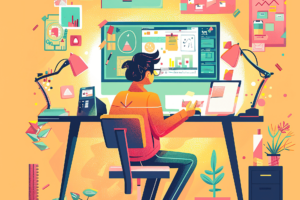Our Offshore Software Development Process: The Ideation Phase
October 7, 2015
This is the first in a series of posts about our project management process for our offshore software development projects. This applies to mobile applications, web applications and pretty much any type of software product. We are obsessed with structured software processes to ensure quality. And we have found that structure allows for more creativity because we don’t have to worry about the process, and can focus more on the end product (mobile apps, web apps).
Sometimes the easiest way to understand a process is to look at an example. How about a new music platform based in Madison, Wisconsin?
This particular example is a consumer facing website. But Augment works with many business to business software products as well.
So, what kind of music platform are we going to build? I want a platform where you can be a part of an artist’s community, see the artist rise up and thrive and be a part of that ride.
So let’s pretend a client comes to us with this idea. How would we start? They have an idea of what they want but the details aren’t quite there. The first phase would include ideation and basic requirements gathering so we can submit a proposal. Ideation involves brainstorming the possibilities of all those little details. Basic requirements gathering involves understanding how to implement those ideas and what ideas should be in phase 1 versus phase 2 or phase 3 of the project.
This blog post will focus specifically on ideation.
Here are some details that the client is interested in incorporating and possibilities we would need to discuss. We love this early part because it is where ideas start to take form and become reality.
- Distribution: One of the first questions I would ask is how will they distribute their product? Ideally they would have multiple musicians interested in the platform before they develop it. Even better they would have interested musicians who could recruit 100 other musicians. Distribution is critical. Websites do not sell themselves.
- Rank Artists: The client says they want to rank artists, but they are not sure how. How about ranking artists based on number of views on youtube, listens on soundcloud, fans on facebook, etc? Ideally we’d also incorporate concert ticket data but that will be more difficult to get. Then we can come up with an algorithm to determine the ranking for each artist. This way you could follow your artist as they rise, or fall, through the music industry.
- Live streaming: Cool. How can we make that happen? Is the client OK using youtube’s live streaming capabilities? That would make development faster and easier. They would also have some extra distribution through youtube as well. Otherwise we could incorporate a standalone video player. In terms of software development, this would not be much more difficult, but the additional servers required, or bandwith they would need to buy, would be expensive. On the upside, the client would have a lot more control.They’d also like to be able to connect ticketing to live streaming for an “online only” show. For this, Eventbrite.com or another service could be incorporated, which would not be too difficult. The tricky part would be figuring out how to easily sign up artists and connect their bank accounts to whatever ticket service we are using. The actual connection would not be difficult, but figuring how to make it easy and seamless for the user could be more challenging.
- Voting: This could be like teespring except each musician would have their own platform. Is there a third party software already available to make this happen? Or will this software application have to be developed from scratch? And should this be a part of the mobile app? Having voting available on a phone would allow for voting during a concert or event.
- Ecommerce: The client wants musicians to be able to sell their paraphernalia, including custom items like ringtones, to fans. For this we could use a number of applications. If we are using wordpress for content management we could use woocommerce. We could also use magento or a multitude of other products as well.
- Lodging: Fans should be able to stay with each other when they’re on the road. It would bring the community closer together. You would have to deal with insurance and security issues. Is it worth the risk? What if the platform had insurance just like Airbnb.com does? This software would likely need to be custom built.
- Sell rights: Allow clients to sell rights to their songs, concerts,etc. This can be done through different blockchain apps. Some custom software development by our offshore developers would still be needed. I think bitshares.org would be the best platform to try out. This idea would make fans an intimate part of their musicians’ enterprise.
This example of building a new music platform includes the client wanting to add multiple different features which can add a lot of complexity to a project. It’s very important to really look at the details in the ideation stage so we can figure out which features our offshore developers can add by incorporating third party software, which they will need to build from scratch and which will need a little bit of both. It’s also important so that in the basic requirements stage, we can discuss which features will fall in which phase of the project. A thorough ideation is the only way Augment and the client can be on the same page and it’s the first step to a successful project.
Related posts

Introducing Auggy AI: A Conversational AI Assistant
Embracing AI sounds easy but it’s often hard to know what and how to implement AI. To that end, we built an internal custom AI assistant. Our AI assistant Auggy is built to respond accurately to questions regarding our internal policies, manage project tasks, and provide updates on JIRA, to create, and view events, allowing …

Why AI
Why are we excited about AI? There is definitely a lot of hype around AI. The hype is exciting but also deafening sometimes. Everyone feels the pressure to build and engage with AI. It’s magical, life changing. That’s kind of all true. But there is a lot of work to be done to achieve that …

Designer Diaries: Our discourse with AI towards customized design
UX designers often face creative blocks, making conceptualization and execution challenging, particularly when working under tight deadlines. Traditional design workflows can be time-consuming and relatively less productive. Hence in an attempt to rapidly generate new ideas, visualize complex information, and interact with the team, we chose to blend AI for the design process. So what …

